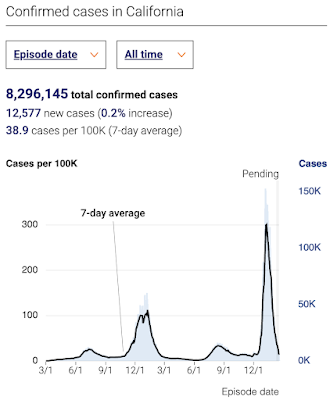On rainy winter days, it can be interesting to watch the behavior of the State of California's amazing water reservoir system.
There are hundreds of reservoirs across the state, many of them fairly small and maintained by various regional authorities, but you can watch all of them in various ways using the state's website.
For the big picture, however, it is easiest to look at the big reservoirs, and I generally only look at what I call "the big three": Shasta, Oroville, and Trinity.
Shasta is the most important just because of its size. It can hold a brain-breaking 4.5 million acre feet of water.
Oroville can hold 3.5 million acre feet; Trinity can hold 2.5 million acre feet.
Oroville sits at the base of the Sierra Nevada range, capturing an incredibly productive watershed that spreads many thousands of vertical feet up the western slope of the northern Sierras.
Trinity is quite interesting because the water in this reservoir is captured from watersheds that would ordinarily flow into the Pacific Ocean, but through the efforts of decades of civil engineering, many million acre feet of water every year from the fantastically wet northwest quadrant of the state is redirected eastward and inland, via Whiskeytown, into the Central Valley.
Anyway, back to watching the reservoir behavior. Here you can see Trinity Lake over the past 12 hours, growing by six hundred acre feet per hour.
Here we can see Oroville Reservoir over the past 12 hours; the lake has been capturing an astonishing four thousand acre feet per hour in this week's storms.
And here's Lake Shasta, which hasn't been growing as much, but is still growing by a thousand acre feet an hour. Note that Lake Shasta's outflows never drop to zero. This is partly for reasons of the behavior of the California electric grid, which demands electricity generation from Lake Shasta around the clock, but also partly because Lake Shasta must always release a certain amount of water in order to keep the Sacramento River flowing properly.
Sit inside, listen to the rain, and enjoy watching the reservoir behavior!












